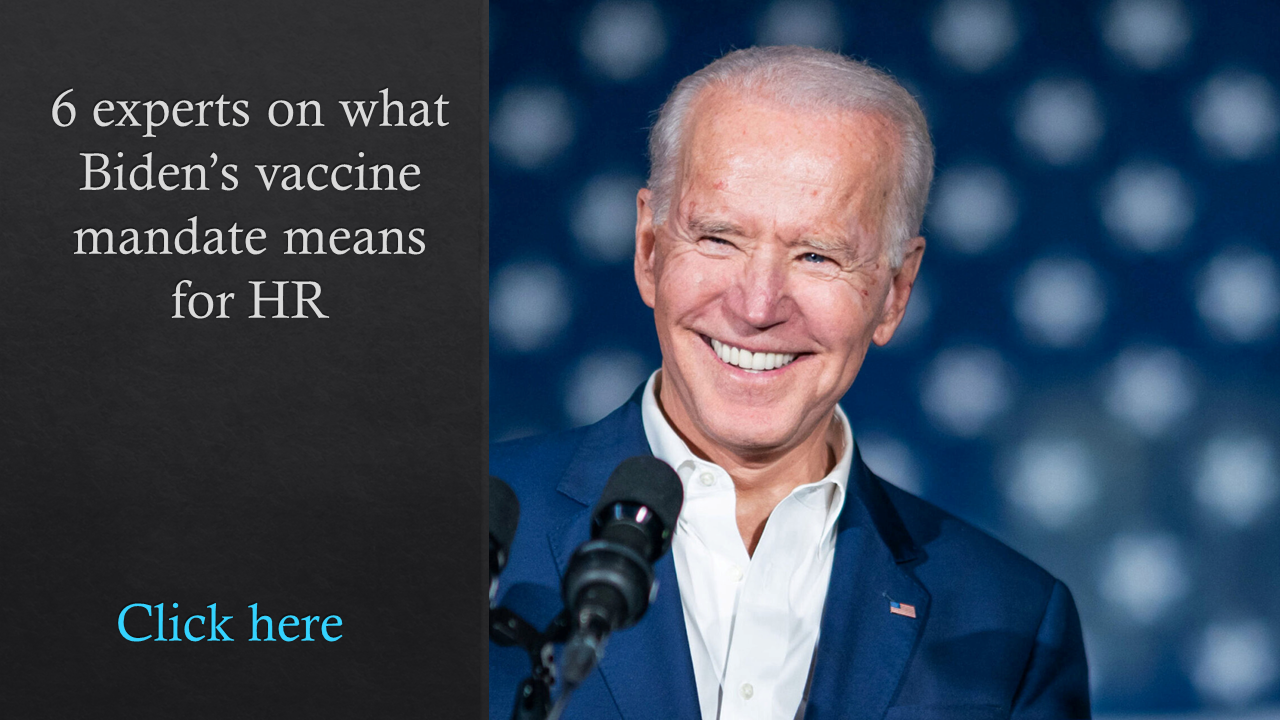Employers are using an array of initiatives, such as paid time off, financial incentives and restricted access in the workplace to increase employee COVID-19 vaccination rates. Yet, many are struggling to achieve the high vaccination rates necessary to prevent continued outbreaks from the contagious Delta variant. In response, the Biden administration announced that businesses with 100 or more employees must implement a vaccine mandate, with surveillance testing as an alternative for unvaccinated employees. As companies wait for clarity from the forthcoming regulations, they are faced with difficult—and urgent—questions of how to best protect their employees and their business. We address seven critical questions that employers should consider as they roll out their own initiatives.
1. Why encourage vaccination now?
Unvaccinated employees represent both a safety and a business risk, as they could expose or infect others at work, are more likely to miss work due to illness or quarantine, and are more likely to have costly COVID-19 hospitalizations. High levels of employee and community vaccination are key to lowering these risks, and employers should plan or take action now as they await the upcoming Occupational Safety and Health Administration (OSHA) Emergency Temporary Standards, which will include the mandate requirement for employers.
2. Which employees should be considered “fully” vaccinated?
Currently, anyone who is fully vaccinated (i.e., two doses of an mRNA vaccine or one dose of a Johnson & Johnson/Janssen vaccine) should be considered vaccinated for the purposes of this mandate. Companies could also consider any employees fully vaccinated if they have completed any World Health Organization-approved vaccine regimen outside of the United States. While the immunosuppressed, the elderly and adults at higher risk are eligible to have an additional dose, employers cannot ask employees if they have a condition that would qualify them for this extra vaccine dose. Moreover, the protection of the initial vaccination course is far more important to reducing community risk than booster shots.
3. What documentation will be required?
A Willis Towers Watson survey in August found that 62% of employers that tracked vaccinations asked employees for some type of proof, such as a CDC vaccine card, while 36% relied on attestation. Three-quarters of employers that tracked vaccinations collected the information internally.
Vaccination or testing records are considered medical information and must be kept separate from personnel files and stored in a secure location. The Health Information Portability and Accountability Act (HIPAA) does not prevent employers from inquiring about employee vaccination status. For both vaccination and testing, documentation can be done either through a vendor or maintained by the employer. OSHA has not yet provided guidance on what will constitute appropriate documentation.
See also: HR lessons from the Southwest vaccine mandate controversy
4. How will exemptions to vaccination be handled?
The Equal Employment Opportunity Commission requires a vaccine mandate policy to offer medical and religious exemptions, and we anticipate that the OSHA regulations will do the same. Your organization will need a protocol to evaluate requests that fall into each of these categories and to consult legal counsel to support this process.
Medical exemptions may be requested based on a prior severe reaction to a vaccine or another condition. Some employees may request an exception due to a previous COVID-19 infection, as prior infection does provide some protection against future infection. But the CDC recommends a full vaccination course even after recovering from COVID-19, as there is data to support improved protection for this group and it’s not clear what level of antibody indicates protection. Thus, previous infection should not be an exception to a vaccine mandate. Pregnant women are at increased risk from COVID and should be encouraged to be vaccinated. Pregnancy should not be the basis of an automatic vaccine mandate exception.
Religious exemptions may be based on a faith tradition or firmly held belief. Notably, several religious organizations have encouraged their communities to be vaccinated, including the Vatican, the National Association of Evangelicals, the National Council of Churches, the Jewish Rabbinical Council of America and the National Muslim Task Force on COVID-19.
5. What timeline is needed for implementing a mandate?
We recommend that employers announce a vaccine mandate a minimum of two months before taking effect to allow for policy development, communication and time for employees to get vaccinated. Starting this process now will increase the safety of the workplace in the coming winter months. If needed, there are vendors that can support the vaccination, testing, exemptions and the documentation process.
6. What testing strategy should be deployed for unvaccinated employees?
Asymptomatic employees who qualify for an exemption or decline vaccination are expected to be allowed to provide weekly test results, at minimum, in the forthcoming OSHA guidance. This can create additional cost and administrative burden, so we recommend that testing be narrowly used for those who qualify for medical or religious exemptions. Testing alone will be less effective in curbing new infections compared to increasing employee vaccinations.
 The two main test options available detect all variant types and are described here. First, employers can use rapid antigen tests. These tests give results in under 30 minutes, are available over the counter and are inexpensive. Antigen tests are easy to distribute, as employers can purchase directly in bulk and distribute to employees who can conduct the tests themselves at home, reducing potential workplace exposure. The antigen tests are especially good at identifying people who are highly infectious. Antigen tests have been in short supply for the last month, but we expect supply to increase in the coming weeks.
The two main test options available detect all variant types and are described here. First, employers can use rapid antigen tests. These tests give results in under 30 minutes, are available over the counter and are inexpensive. Antigen tests are easy to distribute, as employers can purchase directly in bulk and distribute to employees who can conduct the tests themselves at home, reducing potential workplace exposure. The antigen tests are especially good at identifying people who are highly infectious. Antigen tests have been in short supply for the last month, but we expect supply to increase in the coming weeks.
Second, employers can use rapid PCR (Polymerase Chain Reaction) tests, which are highly sensitive and can pick up a new case earlier than antigen tests. They can also remain positive long after someone is no longer contagious. Most PCR tests are performed in a laboratory, so the results are not available immediately. Rapid PCR tests can be done as quickly as 10-15 minutes but usually require technicians and machinery so must be performed on-site.
Related: Mandating vaccines? How tracking tech can help with the next steps
Given the cost and effectiveness of identifying those who could spread infection, antigen tests are likely the more sustainable choice for employers. Some employers will initially deploy PCR testing and move to antigen tests when they become more available. If possible, testing should be done at home, prior to entering the workplace, a method that currently favors the use of rapid antigen tests. Home-based rapid PCR tests may be more widely available in the coming months.
The Biden plan requires that testing should be weekly, but more frequent testing may be appropriate. The Delta variant viral load peaks earlier (within four days on average) than previous strains so testing should be done at least twice weekly if community spread is “substantial” or “high.” Employers with multiple sites should choose testing parameters that best meet the needs of their local situation.
Not all unvaccinated employees should perform surveillance tests for COVID-19. Any employee with symptoms of COVID-19—unvaccinated or vaccinated—should not be at the workplace and should obtain diagnostic testing and support from their healthcare provider. Employees who have recovered from documented COVID-19 do not need routine surveillance testing for 90 days post-infection, as their tests may produce a false positive.
Companies that mandate tests should expect to pay for this testing. Although federal laws don’t require employers to pay for tests they mandate, most state employment laws do.
7. What other actions can help keep employees safe?
Employers can lower the risk of transmission of COVID-19 through improved air quality, including by more rigorous air filtration or a higher number of air exchanges, which provides substantial protection. In addition, masking while indoors can decrease transmission rates, which is why 80% of employers indicate they require masking indoors.
Employers have been working diligently on increasing employee vaccination rates, though many are falling short of their goals. COVID-19 has proved to be an extremely unpredictable nemesis, and employers must do all they can to anticipate the consequences of their many potential responses. Keeping up to date on the latest information and understanding the important questions to ask can help employers find the best set of actions to protect their employees and diminish the risk of COVID-19 to their business.

